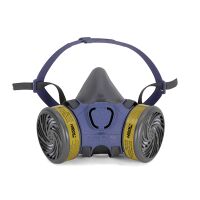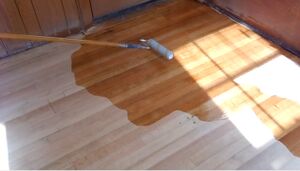Difference between revisions of "Aliphatic Urethane"
| Line 44: | Line 44: | ||
===Avoid Thick Coats of Urethane=== | ===Avoid Thick Coats of Urethane=== | ||
| − | If Urethane is applied in too thick of a layer, it will not cure correctly. You can build up a thick layer of urethane, but it must be over a period of multiple coats. A 3/16-inch roller provides the right amount of thickness. This is due to how the Urethane cures. There are two reactions - a surface cure, and an internal chemical reaction between the resin and hardener. When you put a thick layer down, the two reactions happen at | + | If Urethane is applied in too thick of a layer, it will not cure correctly. You can build up a thick layer of urethane, but it must be over a period of multiple coats. A 3/16-inch roller provides the right amount of thickness. This is due to how the Urethane cures. There are two reactions - a surface cure, and an internal chemical reaction between the resin and hardener. When you put a thick layer down, the two reactions happen at different speeds. |
===The Second Coat of Urethane may Require Less than the First=== | ===The Second Coat of Urethane may Require Less than the First=== | ||
Revision as of 00:25, 12 November 2022
Aliphatic Urethane is a general purpose urethane we sell. It is comparable to oil-based urethanes (but different - do NOT add Mineral Spirits). It is normally a clear resin, but can be purchased in colours, and colour matched. It is a two part resin, one part resin, one part hardener. It is mixed in 2:1 proportions, of 2 Resin for each 1 Hardener. The Resin is part A, the hardener part B respectively.
Common applications for Urethane include coating on top of hardwood floors, concrete, metal, and epoxy finished floors.
Safety
Urethane is flammable. Use Urethane in a well ventilated area. Some form of dust mask or breathing protection is recommended.
Respirator
A recommended Respirator would be the Moldex 7000 Series Reusable Half Mask Respirator link: https://www.moldex.com/product/7000-series-half-mask-respirator/ Note that we sell smaller disposable dust masks, not these.
You should purchase a filter for organic vapors such as the Moldex #7300 Organic Vapor/Acid Gas Cartridges For 7000/7800/9000 Series Respirators link: https://www.moldex.com/product/7000-7800-9000-series-respirator-organic-vapor-acid-gas-cartridge/
You don't have to go with Moldex. There are similar products from 3M. Likely any well known name brand will offer adequate protection. I would recommend buying from official distributors for a product like this. It is not worth cutting corners for a proper respirator.
Application Overview
- Prepare Surface to be coated
- Ensure there is ample lighting in the area. This will help to see progress, especially after the 1st coat.
- Check ambient temperature is at an appropriate level (at or above 65 deg F)
- Mix Urethane resin and Hardener in appropriate amounts.
- Apply with a 3/16-inch Nap roller. Use a brush for hard to reach areas.
- Evacuate, or otherwise close off the area, to avoid the fumes becoming noxious.
- Wait 12 hours for the Urethane to cure
- If necessary, Sand urethane, and apply at least a 2nd coat.
These steps are generalized and omit specific details such as cleaning a surface before application. For more detailed guides and actual use cases see Application Notes.
How to Apply Urethane
First, the surface to be coated should be prepared. This will depend upon your environment. As an example, an oak wood floor would be sanded down to virgin wood, and any damaged wood, cracks, or divots would be repaired. Optionally, a stain may or may not be applied.
Second, you must ensure the temperature is at an appropriate level. Urethane should not be applied if the area temperature is below 60-65 degrees fareinheit. If the temperature is too low, you can use room heaters. Choose heaters that do not emit any sparks or flames, as the Urethane is flammable.
Once the area is prepared, You can mix the Urethane and the Hardener. They are mixed in a 2:1 ratio, with two parts Urethane, to 1 part Hardener. The Urethane can be applied using the roller. To get a proper layer thickness, we recommend a 3/16-inch Nap Roller. A brush can also be used. Once the first coat is applied, the Urethane will cure in 12 hours at 65 deg. F. A minimum of two coats is advised. There is no maximum.
Sand in-between coats with a pole sander, if necessary. The goal is to roughen up the previous layer, so that the next layer will be able to 'bite' or grab on. You also want to remove any dirt or materials that might have gotten into the Urethane when it was curing, or any high spots. Avoid drafts, or outdoor wind that might bring in dirt to the surface.
Futher details can be found in Application Notes.
Tips
Avoid Thick Coats of Urethane
If Urethane is applied in too thick of a layer, it will not cure correctly. You can build up a thick layer of urethane, but it must be over a period of multiple coats. A 3/16-inch roller provides the right amount of thickness. This is due to how the Urethane cures. There are two reactions - a surface cure, and an internal chemical reaction between the resin and hardener. When you put a thick layer down, the two reactions happen at different speeds.
The Second Coat of Urethane may Require Less than the First
For example, when doing a hardwood floor, the first coat will require a bit more, perhaps 15% more Urethane as the wood will soak much of the first (primer) coat. The second coat will use less urethane, therefore less can be made, and less can be poured down at a given time for this 2nd coat.
Do not mix Aliphatic Urethane and Mineral Spirits
Unlike common oil based Urethanes used for wood finishing (Minwax, Fabulon), you can NOT add mineral spirits to this Aliphatic Urethane. Doing so will result in a cloudy cure. There is no need to thin this urethane in order to avoid bubbling, as it rarely bubbles.
Aliphatic Urethane vs. Water vs. Oil based Urethane Hardwood Floor Colour
The appearance of hardwood under Aliphatic Urethane is somewhere between oil and water based Urethanes, with a strong lean towards the oil based Urethanes known for their gold colour on woods such as Oak. For an example, see this Red Oak floor before and after picture with Aliphatic Urethane.
Curing Urethane can Attract Flying Bugs
It is best to use a window with a screen, to offer some ventilation when curing Urethane. Having an open door or window, may cause flying bugs to be attracted to the aroma. If a bug or dirt is caught in a coat of urethane, it can be rubbed or sanded out, with additional urethane applied on top.
Sanding Urethane is Not Always Required Between Coats
If the primer coat of Urethane is rough enough, a 2nd coat can be applied without sanding. Some experience and judgment should be exercised here. However, we do recommend sanding before the final coat.
Use a Solvent to Clean Urethane off of Hands or Tools
A solvent, such as Acetone can be used to clean urethane off of tools and hands after working.
Do not mix different types of Urethane
A mistake would be to think you can mix this Aliphatic urethane with a normal oil based Urethane. Even if the urethane is already cured. The 'thanes will not mix in appearance, and will appear as if they are two different layers of coating. This can be spot tested to confirm. Multiple layers of the same urethane will blend seamlessly, but not necessarily if they are different.
Curing of Urethane Requires Air
With most chemicals we sell you must have adequate airflow or air transfer in the area in order for a proper cure. This of course assumes that the air temperature is not too cold but that is not the focus here.
An example of how this can go wrong: You cure the chemical (e.g. Urethane on a floor) in a small closet, then in order to avoid any exposure, you close the door to the closet. This will likely result in a poor cure. You must allow 'some' airflow to the area. Completely closing up a room is not recommended. Leaving the door open is usually enough.
| ||||||||||


